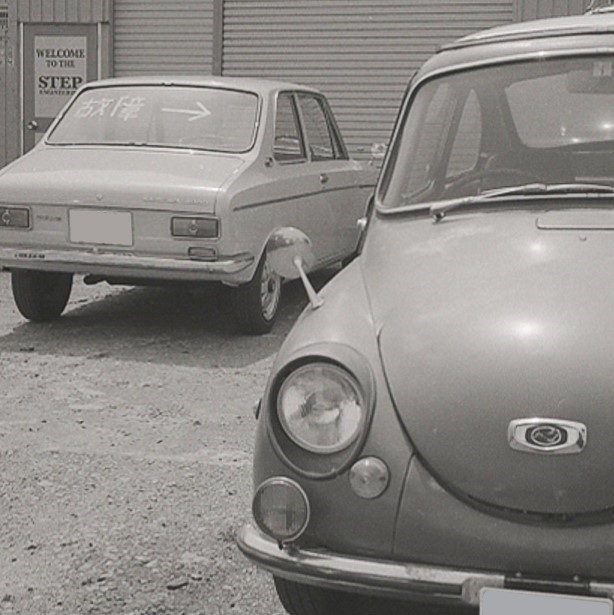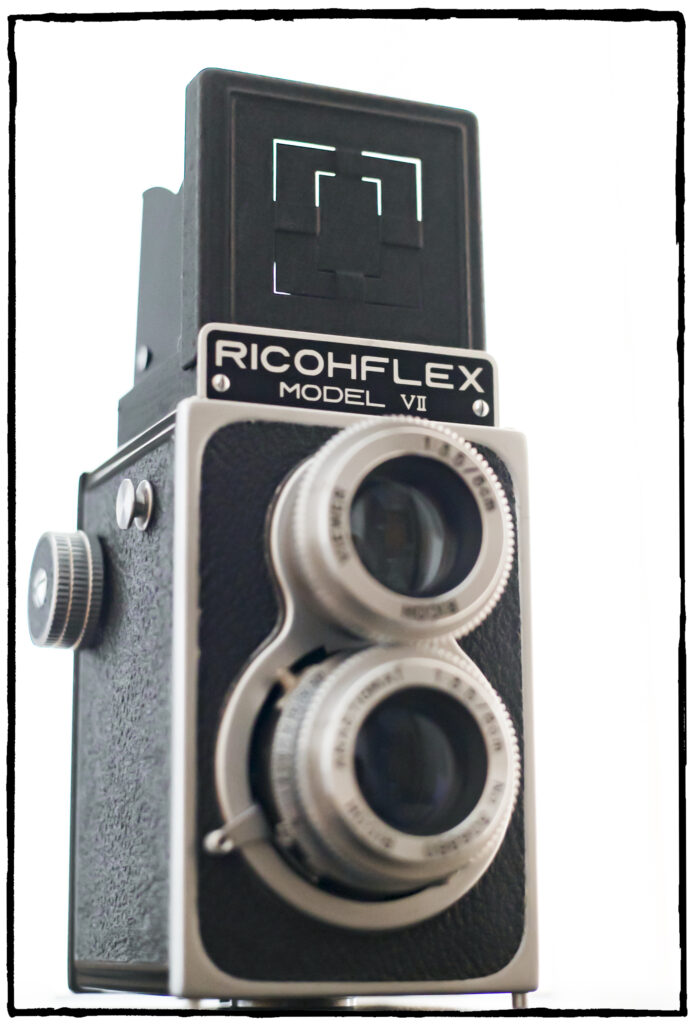Stroclacame(Strolling with a classic camera)Vol.2
camera
column

at first
I’m sorry
Because we can’t speak english
I am using DeepL translate, so it may be a strange sentence,
but I would like you to understand
Thank you
Photographer Okamura’s Whimsical Column
This time a RICOH camera
RICOHFLEX MODELⅦ

RICOHFLEX Ⅶ aperturef8.0 ARISTA.EDU ULTRA 400(The result was multiple exposure)
“Shop Focus”
Failed photo taken with a Ricohflex VII.
Actually, this camera was disassembled and cleaned because of problems with the lens movement and slow shutter speed, but here is a photo taken during the test shooting.
I thought I had cleaned it properly, but it was still not in good condition and there was still dirt on the shutter wings.
The shutter had started moving slowly.
I pressed the lever, but mistakenly thought, “Hey, the shutter didn’t release⁉” and released the shutter for the second time…
The result is the picture above.
I think it turned out to be quite an interesting picture, although I did not intend it to be.
A store in the midst of the trees and grass.
Something that looks like a house is in the picture….I think it might be a shop.
It would have been better if the store had been depicted more clearly.
I didn’t aim for this shot, but it made me want to take a shot like this next time.
This is because this camera is very easy to use for multiple shots.
The film feed and shutter charge are separate operations, so the film is wound once, the shutter is released, and the shutter is released again.
By doing this, the film surface is exposed twice.
At that time, the exposure is cut twice, so there is a possibility that the film will be exposed to the brightness of the second time and the result will be over.
High-end cameras such as the Rolleiflex have a self-cocking mechanism that winds up the film and charges the shutter at the same time.
Therefore, when multiple exposures are taken, the gear must be removed from the crank if the type has a mechanism to remove the gear from the crank so that the film will not wind up.
Medium-format cameras that use Brownie film are suitable for large prints because of their large film format, but it is better to use a tripod to hold the camera steady. Even the slightest camera shake will show up in large prints.
This camera shoots in a size of about 6 cm x 6 cm, which is about four times the amount of information of the film commonly known as 35 mm film, so it can produce delicate expressions.
It is also interesting to note that the image is a perfect square.
Unlike cameras that shoot vertically or horizontally, the shooting style is usually to look straight up, which is smart because there is no need to turn the camera horizontally or vertically, as is obvious.
Since you don’t have to look at the subject, you can concentrate on the angle in the square viewfinder, and with your eye on the viewfinder, you can capture the scene softly with a quiet shutter sound, hardly feeling the hustle and bustle around you. This is why it is so useful for city snaps.
Furthermore, I like the classical look of the product.
I have used and passed by many medium format cameras in the past, such as the YASHICA 124G and the Rolleiflex 2.8F. Now I have only one Rolleiflex 3.5F, but twin-lens reflex cameras will always be a soothing camera to own.
After all, I am fascinated by the gentle sound of the shutter and the soft images, so I need this camera.
What I expected when I tried Ricohflex VII for the first time was, above all, its “photographic quality.
The lens is rumored to be made by Tomioka Kogaku, so if it is made by Tomioka, which is known as the Zeiss of Japan, then expectations are high.

RICOHFLEX Ⅶ aperture f8.0 ARISTA.EDU ULTRA 400
”STEP ENGINEERING, a factory that reconstructs famous cars.”
Click here to visit the official website of STEP ENGINEERING
This is an auto body shop that I often visit and photograph.
The president is young and friendly, and I enjoy talking with him and want to meet him.
Located along Route 82 in Kitanosawa, Minami-ku, Sapporo, Hokkaido, it is lined with numerous Subaru 360s and old cars, so even if you casually pass by, you can’t help but notice it.
A place that seems to have wandered back in time and come here.
I had known about this place for a long time, but I think it was four or five years ago that I first visited. At that time, I was given permission to photograph several old cars that I was interested in.
I needed courage at first because my priority was the desire to photograph rather than purchase, but when I spoke with Mr. Mizuta, the representative, he was very friendly. He not only gave me permission to photograph, but also talked to me about many other things.
He told me many interesting stories, such as that he also does racing, etc. He is a really nice person – I was happy to hear that.
After that, due to the COVID-19 epidemic, I was a little hesitant to visit the restaurant, but I quietly took some pictures for this article.
The Subaru 360, a well-known car, and the Subaru 1000 in the back.
Please be assured that this photo was taken well and is not multiple exposure. (lol)
The contrast is strong and there is a good sense of three-dimensionality.
Perhaps, on the contrary, a more sleepy look, in other words, a blurred picture with low contrast, would be more like that period.
Or you can make it a little out of focus… Some people say it’s a bad idea, but you can try different things and choose the most interesting one… There is also the technique of blowing on the lens and making it a little foggy…
There’s a proper way to use a camera, but if you don’t, you’ll break it.
There is no right or wrong way to express yourself in photography, so just do what you think is good.
I took 12 shots this time, but because the camera was not in good condition, multiple exposures occurred frequently and the shutter speed was not appropriate at times, so I could not show you many good shots. I will clean the camera a little more, or maybe I will maintain it and take more shots and report again.
It would be interesting to shoot with positive film.
Compact and lightweight, this camera has a simple mechanism and promising photographic quality.
It is an attractive twin-lens reflex camera.
Photographer Okamura

RICOHFLEX Ⅶ ANASTIBMAT F3.5
| Release date | February 1954 |
| Release price | $23 $18 from 1955 |
| Lens (3 elements in 3 groups) | 80mm Anastigmat |
| Viewer lens 3 groups 3 elements | 80mm Ricoh viewer |
| Number of aperture blades | 2 |
| Seiko shutter | B~1/500 |
| Width x Height x Depth (mm) | 72.5x 183×110 |
| Weight ( Oz) | 27.5 |
| The film | Brownie (120) 6×6 format |
Vintage Shop Japan Inc. Official Website
Official website (English) URL
Official website (Japanese) URL
facebook URL
Instagram URL
Pinterest URL
#ricohflex
#twinlensreflexcamera
#vintageshopjapan
